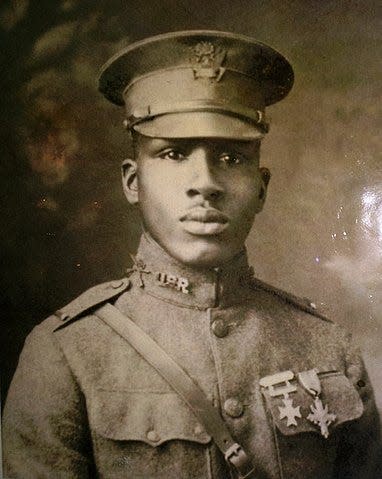A Black soldier from Lyles Station, Indiana, will be honored by the state on Saturday
More than 380,000 African-American soldiers served in World War I. Now, the state of Indiana is set to unveil a marker to honor one from Gibson County whose career spanned from the trenches of World War I to officer training at an American university.
Aaron Richard Fisher, a highly decorated, officer, was chosen after an application was sent in on his behalf from a doctoral student in Louisville. The marker dedication ceremony will take place Saturday at 1 p.m. at the Lyles Station Historic School and Museum.
Fisher was born in 1896 to Benjamin and Macy Octavia Barnhill Fisher at Lyles Station in Gibson County, Indiana. His father was a farmer and Civil War veteran who served in the 6th Regiment of the United States Colored Cavalry. His mother died when Aaron was 10 years old.
After attending elementary school at Lyles Station, Fisher attended the all-Black Lincoln High School. In February 1911, he enlisted in the army at was stationed at Jefferson Barracks in Missouri at age 15.
It was the start of what would become a 50-year career in the military.
Aaron Richard Fisher's military career
Fisher trained in Leon Springs, Texas, and then Camp Sherman, Ohio, where he was assigned to the 9th Cavalry Regiment before being transferred to the 24th Infantry, where he was promoted to corporal.
In the 24th Infantry, Fisher took part in the Mexican Punitive Expedition, an operation by the U.S. military against paramilitary forces in Columbus, New Mexico.
He remained station in the American southwest until the United States entered World War I in 1917.
During World War I, the military segregated white and African-American units, which still served under white officers. Mostly, African-American soldiers were sent overseas to serve as non-combat troops and perform labor for the army. This included loading and unloading ships at the dock, ship repair and refueling, and working on roads and railways.

Wanting a change in these roles, African-American leaders pushed for soldiers to be sent into combat.
American Expeditionary Forces Commander Gen. John Pershing approved two Black infantry divisions to combat duty: the 92nd and 93rd divisions. Both were assigned to serve with the French Army, who were in need of troops.
The 92nd would fight largely under American commanders while the 93rd division would have French commanders.
By the time he made it to France in June 1918, Fisher was a second lieutenant.
While in Lesseux, France, Fisher’s unit manned a trench salient in September 1918. A German raid left Fisher's unit outnumbered, but he and his fellow soldiers held their position until a counterattack aided them.
Afterward, FIsher was sent to a hospital in Toul, where he was treated for wounds and gas exposure. He remained in Europe with the Army of Occupation until February 1919.
Fisher was awarded the Distinguished Service Cross and a Purple Heart. The French government awarded him the Croix de Guerre with a gold star.
Life after World War I
After being discharged in 1919 as a commissioned officer, Fisher went through the armed services in several different roles, including work in the Southwest and a two-year tour of duty in the Philippines. Fisher eventually transferred to an ROTC unit at Wilberforce University, where he trained several officers who served in World War II, including Medal of Honor recipient John R. Fox.
Because of health problems, Fisher retired from that job at 55 and moved on to a stock-control clerk position at Wright-Patterson Air Force Base in Ohio, which he held until May 1965.
Fisher passed away on Nov. 22, 1985, at age 89.
When asked why Lyles station was chosen as the location for his marker, Pfeiffer stated that “it highlights the history of early African American settlements in the state.”
Fisher’s marker will be the fifth one placed in Gibson County.
Wanting to honor and commemorate African-American soldiers who fought overseas and the Jim Crow laws that they faced, the marker is a reminder of headway made for future troops.
“It really is a way to commemorate African-American contributions during World War One, and African American contributions in the military in general,” said Casey Pfeiffer, Historical Marker Program director for the Indiana Historical Bureau Division.
Rayonna Burton-Jernigan covers diversity and culture-related topics and can be contacted at rbj@courierpress.com or (812) 454-1765.
This article originally appeared on Evansville Courier & Press: Indiana honors Black World War I soldier Aaron Richard Fisher
